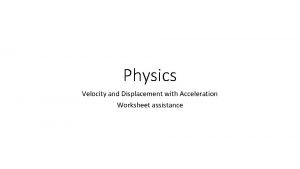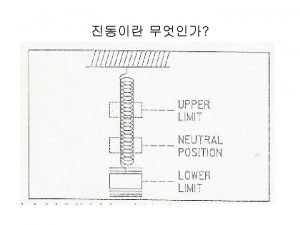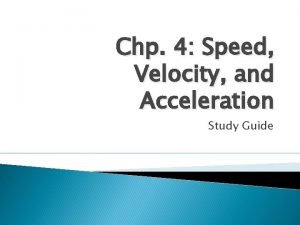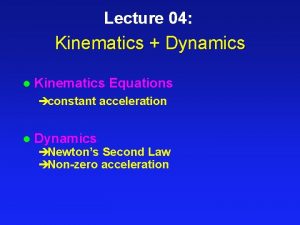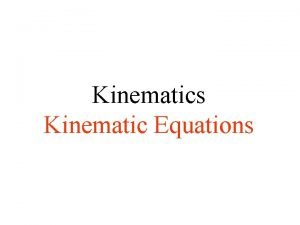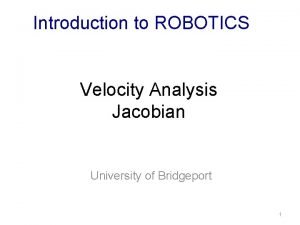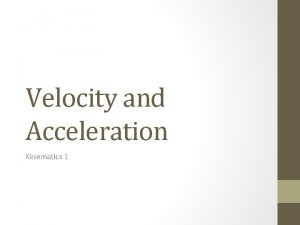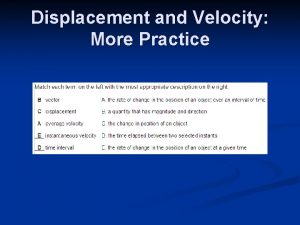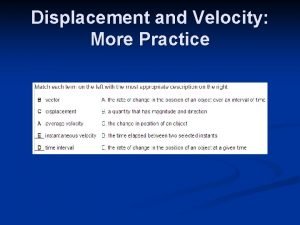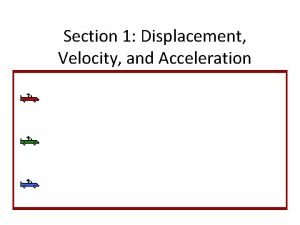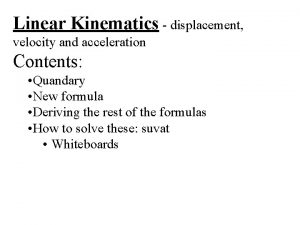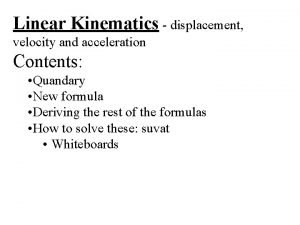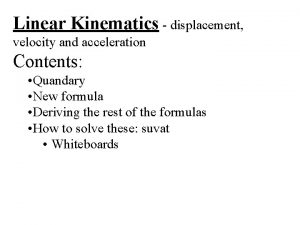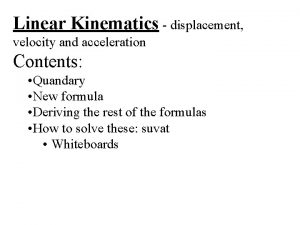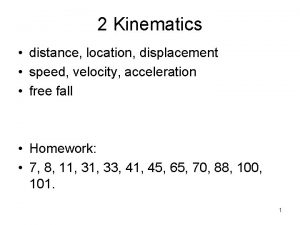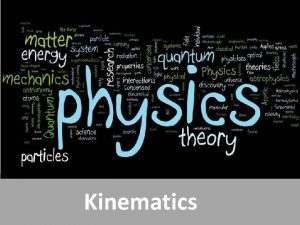Kinematics Displacement Velocity and Acceleration Mechanics The study













- Slides: 13

Kinematics Displacement, Velocity and Acceleration

Mechanics: The study of how matter and forces interact, on a macroscopic scale. Kinematics: The part of mechanics concerned with the study of motion, without consideration of its causes. Dynamics: The part of mechanics concerned with the study of motion and its causes, notably forces.

Kinematics Speed and Velocity - Both are measured in ms-1 - Speed is a scalar while velocity is a vector Average Speed = Distance travelled Total time v= s t Average Velocity = Change in displacement Total time v = ∆s ∆t These are both averages as they may vary over the period of time taken. Note: Many of the examples we study involve linear motion: things moving in straight lines. Also, the direction is not always stated for a vector quantity if it is clear.

Q. Arthur takes a walk from home, around the park and back to where he started. If he walked 2. 7 km over fifteen minutes, determine… a. b. c. d. his distance travelled. = 2700 m his total displacement. = 0 his average speed. = 3 ms-1 his average velocity. = 0

Frames of Reference Measurements can be made from different viewpoints, known as ‘frames of reference’. E. g. To an observer, a building appears to be at rest. However to a driver of a passing car, the building appears to be moving away at high speed. The stationary observer, and the driver of the car, both have a different frame of reference. Frames of reference link

Relative Velocity If two moving objects have different velocities, their relative velocity depends upon which frame of reference you are using. If we know the velocities of two bodies in the same frame of reference, the velocity of body A with respect to body B is given by… v. AB = v. A - v. B E. g. Car X moves at 20 ms-1 to the left, car Y at 16 ms-1 to the right. What is the velocity of X w. r. t. Y? v. XY = v. X – v. Y = 20 - (-16) = 36 ms-1 (taking to the left as the +ive direction)

E. g. 2 A bird flyi

Acceleration is what happens when the velocity of a body changes. It is a vector quantity. Average Acceleration = Change in velocity Total time taken a= v–u t or a = ∆v ∆t ( v = final velocity, u = initial velocity ) Q. Rearrange this formula to make v, u and t the subjects.

Some typical apparatus for linear motion experiments: - One light gate and a double interrupter card - Two light gates and a 10 cm card. - Ticker timer - Distance sensor, interface and computer - Stopwatch - Trap door and digi-timer

Subtitle Text

Subtitle Text

Subtitle Text

Subtitle Text
 Displacement velocity and acceleration worksheet
Displacement velocity and acceleration worksheet Vibration displacement velocity acceleration
Vibration displacement velocity acceleration Is v final velocity
Is v final velocity Speed unit
Speed unit Speed velocity and acceleration study guide answers
Speed velocity and acceleration study guide answers Aplusphysics kinematics-horizontal kinematics
Aplusphysics kinematics-horizontal kinematics Equation of kinematics
Equation of kinematics Solving kinematic equations
Solving kinematic equations Kinematics of rigid body
Kinematics of rigid body Jacobian singularity
Jacobian singularity Single displacement vs double displacement
Single displacement vs double displacement Fluid kinematics example
Fluid kinematics example Angular quantities
Angular quantities Angular acceleration and linear acceleration
Angular acceleration and linear acceleration
